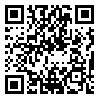Volume 12, Issue 9 (Azar 2014)
Nursing and Midwifery Journal 2014, 12(9): 842-849 |
Back to browse issues page
Download citation:
BibTeX | RIS | EndNote | Medlars | ProCite | Reference Manager | RefWorks
Send citation to:



BibTeX | RIS | EndNote | Medlars | ProCite | Reference Manager | RefWorks
Send citation to:
Mousavi M S, Taghadosi M, Rezaie Shahsavarloo Z, lotfi M S. NURSING STAFF VIEWS ABOUT THE BARRIERS TO PATIENT EDUCATION AND PROVIDED STRATEGIES TO IMPROVE IT IN HOSPITALS AFFILIATED TO KASHAN UNIVERSITY OF MEDICAL SCIENCES, 1391. Nursing and Midwifery Journal 2014; 12 (9) :842-849
URL: http://unmf.umsu.ac.ir/article-1-1348-en.html
URL: http://unmf.umsu.ac.ir/article-1-1348-en.html
Masoumeh Sadat Mousavi1 
 , Mohsen Taghadosi1
, Mohsen Taghadosi1 
 , Zahra Rezaie Shahsavarloo1
, Zahra Rezaie Shahsavarloo1 
 , Mohammad sajjad Lotfi *
, Mohammad sajjad Lotfi * 
 2
2

 , Mohsen Taghadosi1
, Mohsen Taghadosi1 
 , Zahra Rezaie Shahsavarloo1
, Zahra Rezaie Shahsavarloo1 
 , Mohammad sajjad Lotfi *
, Mohammad sajjad Lotfi * 
 2
2
1- Faculty of Nursing and Midwifery, Kashan University of Medical Sciences
2- Faculty of Nursing and Midwifery, Kashan University of Medical Sciences , sajjad.lotfi@yahoo.com
2- Faculty of Nursing and Midwifery, Kashan University of Medical Sciences , sajjad.lotfi@yahoo.com
Abstract: (7446 Views)
Abstract
Background & aims: Patient education is one of the most important principles in the care and treatment process programs. Previous studies indicated that many patients are not given the proper education. The aim of this study is to evaluate nurses' opinions about the patient’s education barriers, and providing some strategies to improve it, in Kashan, in 2012.
Materials & Methods: This cross sectional study was done on 250 nurse and 20 nurse managers in the hospitals affiliated to Kashan University of Medical Sciences. The data was collected by questionnaire including demographic characteristics, barriers and facilitators to patient education. Data were analyzed by descriptive and analytic (Analysis of variance (ANOVA) and chi-square) statistics, and by a confidence interval of 95% by SPSS v16.0.
Results: The most important barriers for patient education are as follows: lack of proportionality between the number of patients and number of nurses, Lack of time and excessive workload, nurses’ insufficient satisfaction with working shifts and hours, conducting unprofessional works, and insufficient overcome.
A significant difference was found between conducting unprofessional works and position, so that nurses mentioned it as a barrier to patient education, but nurse managers did not.
Conclusion: According to the results, in order to improve the quality of patient education, barriers with higher frequency should be modified and adequate budget and equipment should be provided educational needs for the nurses.
Keywords: patient education, barriers, facilitators, nurse, patient
Address: Department of Medical-Surgical Nursing, Kashan University of Medical Sciences, Kashan, I.R. Iran
Tel: (+98)9390315269
Email: sajjad.lotfi@yahoo.com
Type of Study: Research |
Subject:
مدیریت پرستاری
Send email to the article author
| Rights and permissions | |
 |
This work is licensed under a Creative Commons Attribution-NonCommercial 4.0 International License. |



 gmail.com, unmf
gmail.com, unmf